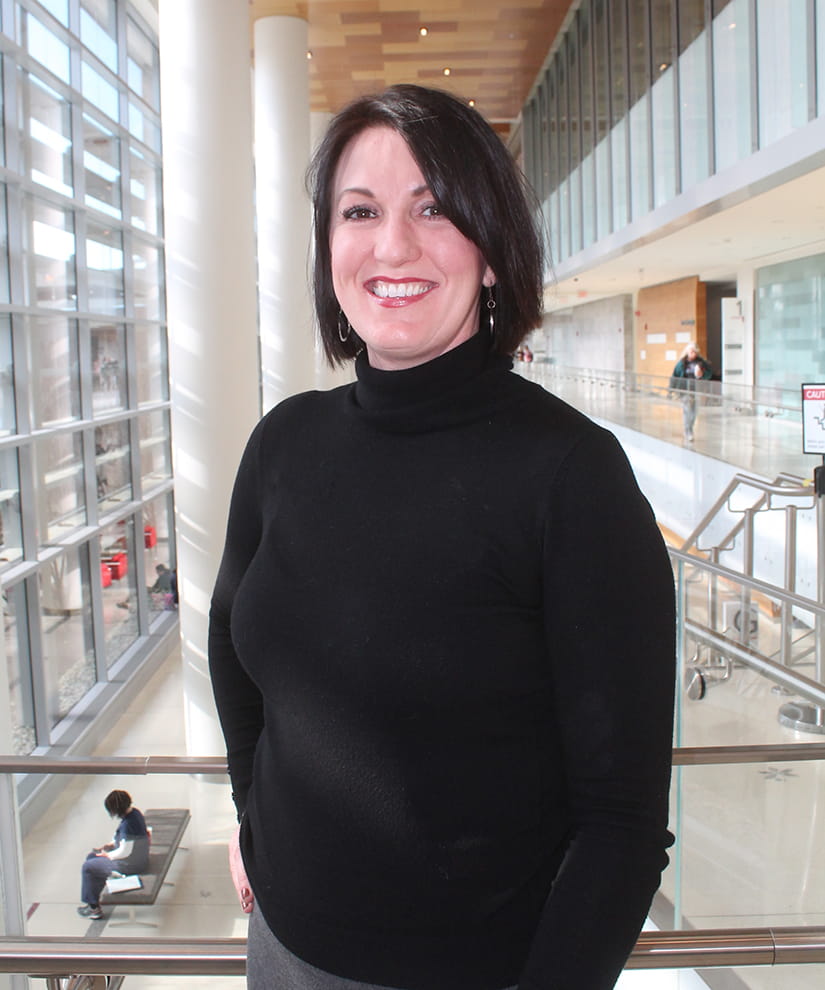 When the Veterans Affairs Maryland Health Care System named Mindy Conklin, MRT, RRT-RCT as its first advanced practice respiratory therapist (APRT) in July 2023, she was also the first APRT in the nation and the first such professional in this new allied health field to be hired by the Veterans Health Administration.
When the Veterans Affairs Maryland Health Care System named Mindy Conklin, MRT, RRT-RCT as its first advanced practice respiratory therapist (APRT) in July 2023, she was also the first APRT in the nation and the first such professional in this new allied health field to be hired by the Veterans Health Administration.
Conklin’s new role was made possible by the advanced Master of Respiratory Therapy (MRT) degree at The Ohio State University School of Health and Rehabilitation Sciences (HRS), the first program of its kind in the country to prepare respiratory therapists as advanced practice providers to meet a critical gap in the health care system.
The number of cardiopulmonary patients nationwide outnumbers the physicians available to care for them, says Conklin, who was among the MRT program’s first graduating class in 2021. “With 34 million patients in the United States who have chronic lung disease, there’s not enough physicians to see them, especially in the rural areas.”
Patients often have to wait over 100 days to see a sleep doctor and 150 days to see a cardiopulmonary doctor, Conklin says. “As APRTs — being physician extenders — we can fill that gap and help treat these patients to keep them out of the hospital.”
The new MRT program at HRS provides respiratory therapists with the advanced training to make that happen, says Sarah M. Varekojis, PhD, RRT, RRT-ACCS, FAARC, HRS clinical professor and director of Clinical Education.
The program trains respiratory therapists to provide critical functions, including provide consultation in decision making and planning for clinical respiratory care services, order diagnostic tests and respiratory care services, initiate consults/referrals, authorize and supervise licensed respiratory therapists and assume leadership roles to apply evidence-based practice.
Varekojis credits the development of the MRT’s clinical component of the curriculum to the school’s partnerships with nationally ranked physician resources at The Ohio State University Wexner Medical Center and Nationwide Children’s Hospital.
“We’ve had excellent support from physicians in pulmonary, critical care, anesthesiology, sleep, neonatology, interventional pulmonologists — every aspect where our students need to have work experience,” she says. “That’s not something that most education programs can take advantage of.”
Students also have access to state-of-the-art pre-clinical training in any one of three clinical skills labs on campus, she says: the new HRS clinical skills lab in Atwell Hall, the College of Nursing skills lab, and the Clinical Skills Education and Assessment Center in Prior Hall.
Furthermore, MRT students can take some of the advance practice provider courses at the College of Nursing and the HRS graduate-level evidence-based practice courses. “Being able to collaborate with others at the advanced level is an excellent foundation for the students,” Varekojis says.
Making an impact
Conklin says the HRS MRT program’s 1200 clinical hours in between ICU and outpatient settings helped build her confidence as an APRT to have her own practice clinics in the Maryland VA.
In addition to working in collaboration with physicians in the cardiology and pulmonary services in the cardiac and medical ICUs and outpatient clinics, she established three clinics: a tobacco health treatment clinic, a sleep clinic and a pulmonary clinic.
“I have the clinics to myself, so I’ll follow the patient to prevent them from being admitted to the hospital with any kind of COPD exacerbation or any kind of pulmonary health issue.” Many people who have chronic lung disease don’t even know it, she says.
APRTs can not only bridge that gap for those patients, she says, “but we can go beyond that and educate and treat them with medications and order the diagnostic tests to see if they have chronic lung disease.”
For example, educating patients on the proper use of an inhaler can have tremendous impact, she says. “A lot of patients do this incorrectly, and end up in the hospital.”
The clinic impact is already seeing results. “Since I started here, our VA has had a zero-readmission rate for COPD exacerbations,” she says.
Looking forward
Creating an educational program for an emerging and critical health care profession that is still ironing out the details on licensure and accreditation continues to evolve, but all signs are good for the road ahead, say HRS leaders.
“The MRT program will also draw additional individuals to the respiratory therapy profession,” says Georgianna Sergakis, PhD, RRT, program director for both the Bachelor of Science in Respiratory Therapy and the MRT programs.
Sergakis says that students considering an RT major might be attracted by the opportunity to pursue clinically related graduate study, similar to the nursing profession. “With the current national demand for respiratory therapists, we hope that the MRT will continue to draw the best and brightest into rewarding RT and APRT careers.”
Varekojis adds that among the 14 graduates of MRT program, “many have leveraged the fact they have an advanced degree,” with roles that call on their advanced clinical expertise, whether in committees and other leadership roles in hospitals, or as consultants and practitioners in private practices.
The good news for HRS MRT graduates, Conklin says, is that the need is great everywhere, and “APRTs are going to shine.” She adds: “My goal is to expand the APRT profession throughout the VA nationwide.”
She says her own experience is an exciting example of what graduates can accomplish.
“This degree prepared me for the role to be a physician extender and gave me the education, knowledge and the confidence that I can step up and do something new. It gave me the leadership skill set to basically help build this new profession from the ground up.”
